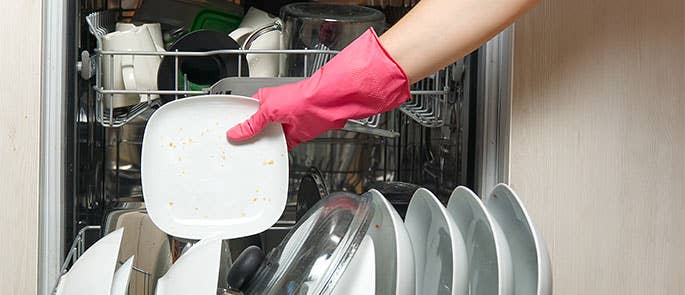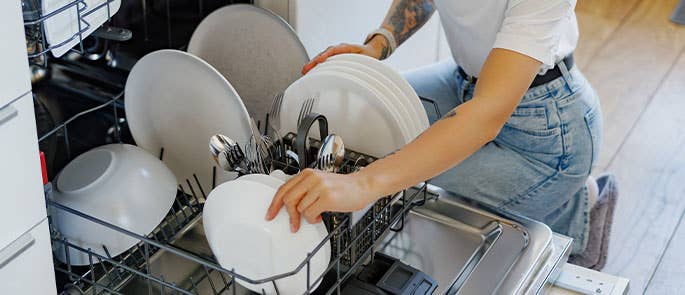How to Load a Dishwasher
You probably know the frustration of opening the dishwasher only to find your plates are still dirty and your glasses are covered in water spots. Often, the problem is not the dishwasher itself but how it has been loaded, so learning the correct loading technique can make a huge difference, saving time, water and energy. In this article, we’ll explain how to load a dishwasher correctly to ensure your dishes come out clean and hygienic every time.

Common Dishwasher Mistakes
Even with the most expensive or technology-focused dishwasher, poor loading can lead to disappointing results. Some of the most common dishwasher mistakes include:
- Overcrowding the racks – when dishes are packed too tightly, water and detergent cannot circulate properly, leaving some items dirty.
- Placing items incorrectly – plates, bowls and utensils must face the spray arms to be washed efficiently.
- Blocking the spray arms – the spray arms spin to distribute water, so if large dishes or pans block them, the cleaning performance will drop.
- Pre-rinsing dishes unnecessarily – modern detergents are designed to work with small amounts of food residue, so completely rinsing dishes beforehand can actually make detergents less effective.
- Forgetting to scrape off large food debris – while pre-rinsing is not needed, larger bits of food can clog filters and reduce cleaning power.
- Not cleaning the filter regularly – a clogged filter affects water circulation and can cause unpleasant odours. Cleaning it every few weeks keeps the dishwasher running efficiently.
- Using too much or too little detergent – too much can leave streaks or residue, while too little may not clean effectively. Always follow the manufacturer’s recommendations.
- Loading non-dishwasher safe items – some materials can warp, dull or even cause damage to your machine, so always check before loading.

What not to Put in a Dishwasher
Not everything is dishwasher safe and some items can be damaged by heat or detergent, or have the potential to damage other dishes. Avoid putting the following in your dishwasher:
- Wooden utensils or chopping boards.
- Cast iron or non-stick cookware.
- Fine china, crystal or hand-painted ceramics.
- Sharp knives, which can dull more quickly.
- Insulated mugs or bottles, as the heat can break their seal.
- Copper, brass or aluminium items, which may discolour.
How to Load a Dishwasher Bottom Rack
The bottom rack of your dishwasher is designed for larger, heavier items that need a stronger water spray. These heavier items should always be placed facing down or at an angle, so the spray can reach every surface. The bottom rack is where you should load:
- Large bowls
- Plates
- Pots and pans
- Baking trays and casserole dishes

How to Put Bigger Bowls in a Dishwasher
Place larger bowls facedown or tilted towards the centre spray arm. Avoid stacking them directly on top of each other, as this can block water flow.
Top tip: Try alternating their direction if you have several large bowls, allowing water and detergent to reach between them more easily.
How to Load Plates in a Dishwasher
Place plates between the prongs, all facing towards the centre spray arm. This ensures that water can hit both sides of the plates evenly.
Top tip: Group similar-sized plates together to stop smaller ones from being overshadowed by larger dishes, improving water coverage.
How to Load Pots and Pans in a Dishwasher
Position pots and pans at the sides or back of the bottom rack, facedown or at a slight angle. This allows water to drain and prevents pooling.
Top tip: If a pot or pan has burnt-on residue, soak it for a few minutes before loading or use the dishwasher’s intensive cycle for better results.
How to Load Large Items in a Dishwasher
Large items like serving trays or baking sheets should go at the sides or back of the bottom rack. Place them at an angle so they do not block the spray arms or prevent the detergent dispenser from opening.
Top tip: Always check that large trays do not cover smaller items underneath, as this can lead to poor cleaning results.
How to Load a Dishwasher Top Rack
The top rack of the dishwasher is designed for smaller or more delicate items as it has a gentler water pressure. The top rack is where you should load:
- Glasses
- Small bowls and containers
- Plastic items
- Cooking utensils
How to Load Cups in a Dishwasher
Place glasses and mugs upside down and between the prongs to prevent rattling and breakage. Ensure there is enough space between them to avoid chips or cracks.
Top tip: Angle cups slightly so that water drains away and you avoid collecting water on the base after the cycle has finished.
How to Put Small Bowls in a Dishwasher
Smaller bowls, such as soup or cereal bowls, should be placed upside down on the top rack. Angle them slightly if possible so that water can drain away during drying.
Top tip: Keep similar shapes together so they sit securely and do not move around during the wash.
Can Plastic Go in the Dishwasher?
Plastic items can go in the dishwasher as long as they are labelled ‘dishwasher safe’. Always place plastics on the top rack, away from the heating element at the bottom, to prevent warping or melting. This includes takeaway containers, children’s plates and plastic cutlery.
Top tip: Use a cooler wash cycle for plastic items, as it helps preserve their shape and prevents discolouration.
How to Load Silverware in a Dishwasher
Silverware, such as cutlery, can go in one of two places, depending on your dishwasher’s design:
A cutlery basket
- Avoid ‘nesting’ by mixing different types of cutlery in each part of the basket so that they don’t stack together.
- Alternate the direction of handles to allow better water flow.
- Always load knives with their handles facing up for safety.
- For a sparkling finish, separate silver items from stainless steel to prevent a chemical reaction that can cause marks.

A third rack/sliding tray
- Lay utensils, such as serving spoons and spatulas, flat and space them out evenly.
- Position spoons and similar-shaped utensils slightly apart so they do not overlap and block water from reaching them.
Loading your dishwasher correctly only takes a few minutes but makes a big difference to the end result, ensuring that every cycle leaves your dishes sparkling clean and ready to use. Efficient loading also helps your appliance run more effectively, saving energy and prolonging its lifespan. With the right loading technique, your dishwasher can truly do the hard work for you.
Further Resources:
- Food Hygiene Courses
- How to Clean a Dishwasher
- How to Clean a Kitchen
- Do You Know Which Fridge Shelves You Should Store Your Food On?
- How to Store Food in the Freezer







